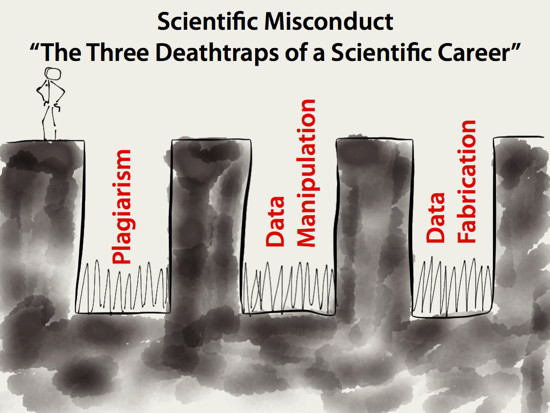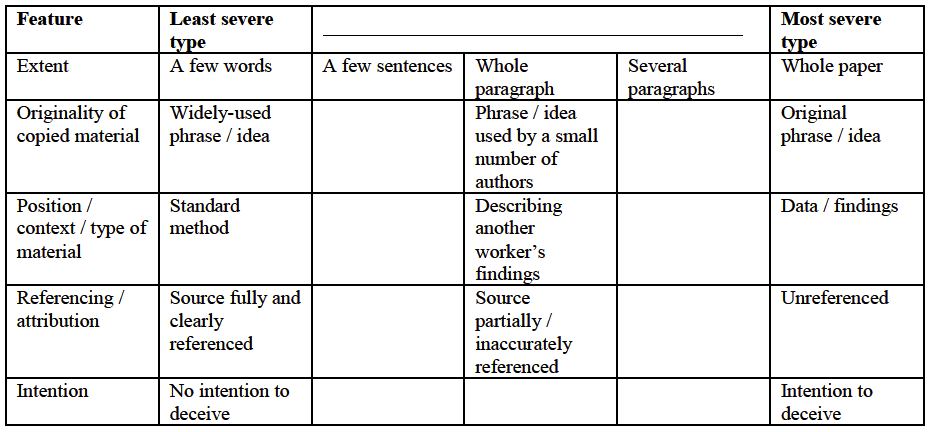A column about errors will contain errors.
Bill Gold
When we talk about misconduct in science, there usually are three deathtraps that can (should) kill a career:
- plagiarism
- data manipulation
- data fabrication

The consequences of these kinds of misconduct are severe (e.g., Bartlett & Smallwood, 2004, Lab Times, 2011, Luke & Kearins, 2012), they:
- damage/destroy the career of the person who is guilty of misconduct (and the career of his/her co-authors, PhD students)
- damage (directly or indirectly) the careers of other researchers (e.g., if they build upon a work that is now called into question)
- lead to wrong decisions in practice (e.g., people think they know what is better supported when in fact the data was made up or researchers get jobs/responsibility beyond their capability if they plagiarized others)
- paralyze scientific research (e.g., due to increased insecurity, tension and the resources which become occupied in dealing with the misconduct)
- damage the image of the field/domain (e.g., some public cases of scientific misconduct raise questions about the supposed objectivity and self-correction of science)
- undermine the standards of quality in the field/domain (e.g., it gives the impression that advancing no matter how is more important than integrity)
Given that the scientific method(s) are usually the best ways to deal with societies problems, we cannot afford scientific misconduct, not for ourselves and certainly not for society.
The focus of these postings is on plagiarism. I’m going through a few things I have read recently and try to highlight a few interesting issues.
There are many definitions of plagiarism, but the core aspect is the lack of attribution (Luke & Kearins, 2012), nicely put by this quotation:
“Plagiarism is the appropriation of another person’s ideas, processes, results or words without giving appropriate credit.”
United States Commission on Research Integrity, 1995
In contrast to everyday thievery, plagiarism steals what is most important in science: the recognition of the work (e.g., Bartlett & Smallwood, 2004). It’s with papers and publications — and the ideas and work behind them — that people (should) advance in science. Stealing someone else’s work, claiming to have come up with an idea, an argument structure, data, etc. oneself while in fact having it copied from an unattributed source is unethical and damaging. It’s not a victimless crime (see consequences of misconduct above).
No wonder plagiarism is usually (at least formally) frowned upon and forbidden. In my discipline (psychology) we have the Publication Manual of the American Psychological Association (2009), which states:
1.10 Plagiarism and Self-Plagiarism
Plagiarism. Researchers do not claim the words and ideas of another as their own; they give credit where credit is due (APA Ethics Code Standard 8.11, Plagiarism). Quotation marks should be used to indicate the exact words of another. Each time you paraphrase another author (i.e., summarize a Passage or rearrange the order of a sentence and change some of the words), you need to credit the source in the text. (p. 15)
and
The key element of this principle is that authors do not present the work of another as if it were their own work. This can extend to ideas as well as written words. If authors model a study after one done by someone else, the originating author should be given credit. If the rationale for a study was suggested in the Discussion section of someone else’s article, that Person should be given credit. Given the free exchange of ideas, which is very important to the health of intellectual discourse, authors may not know where an idea for a study originated. If authors do know, however, they should acknowledge the source; this includes personal communications. (p. 16)
However, plagiarism is not clear cut — it’s not solely black or white (but those definitely exist, well at least the black), there are also shades of grey.
Wager (2011) distinguishes between the following features of plagiarism:
She also refers to author seniority (e.g., young researcher unsure of the rules) and language (e.g., English as second language).
Personally, I think the supervisor is responsible when a PhD student conducts plagiarism due to not knowing the rules, and regarding language — let’s just say, that’s what proofreaders are there for. If you cannot write well enough in the language of science for a proof reader to work with, how can you read it and develop it further?
Given the prevalence of plagiarism in the political landscape of Germany (that’s where the “Big Fat Kill”‘s are), a German online magazine has provided a list of different kinds of plagiarism. Roughly translated(*) they (Spiegel.de) refer to:
- full-text plagiarism: text was used without changes and without attribution
- self-plagiarism: own text was used without changes and without attribution
- structure plagiarism: follows thoughts/argument chains of other authors without attribution
- translation plagiarism: translated a foreign text without attribution
- collage technique: combines fragments from different sources without attribution
- obfuscation: words from an unattributed source are repositioned
- false paraphrase: summary of an unattributed source
- pawn sacrifice/fall guy: only a part of the used text is attributed
In this context I would also mention scientific misconduct when it comes to authorship. The only difference here is that in these cases people usually know each other better than in the other kinds of plagiarism. The two frequent issues in authorship are Ghost-Authorships and Gift-Authorships (e.g., see Albert & Wager, 2003):
- Ghost-Authorship: A person is not listed as author of a paper despite having made a significant contribution. This is sometimes the case when PhD students write research proposals for research foundation grants. Given that you have to have finished your PhD to be qualified to submit the grant, some unethical department heads let PhD students write (major parts of) the proposal and then justify the lack of attribution by referring to the submission rules. Another ‘argument’ in this case is that the money is important — and sometimes used to finance this PhD student’s PostDoc position. However, while the money is important, it is also therefore important who got the money. Being able to acquire research money is something that makes PhD students/PostDocs very attractive for new positions. No wonder some dishonest department heads want to remove the visibility of their high-performing PhD students and PostDocs and put themselves front and center.
- Gift Authorship: A person is listed among the authors of the paper despite having made no significant contribution. In many cases there is a power imbalance involved, e.g., the head of the department asks or demands to be listed as author by virtue of having glanced at the title or having heard about the paper’s existence. It might even be seen as ‘normal’ in many departments. However, it is usually also labeled as misconduct and it is damaging for the other authors, esp. if these are junior researchers. After all, if someone sees a department head on the paper this person might attribute a majority of the ideas to this person’s guidance, even when it was completely absent.
While a supervisor who, well, supervises a PhD student should be co-author if this supervisor actually supervises the PhD student and has contributed to the paper, being a department head alone is not sufficient for co-authorship or for sole authorship. For example, the International Committee of Medical Journal Editors (ICMJE) stated in the Vancouver Protocol:
“Authorship credit should be based only on:
(1) substantial contributions to conception and design, or acquisition of data, or analysis and interpretation of data;
(2) drafting the article or revising it critically for important intellectual content; and
(3) final approval of the version to be published.
Conditions (1), (2), and (3) must all be met.
Acquisition of funding, the collection of data, or general supervision of the research group, by themselves, do not justify authorship.”
Many journals follow these guidelines and there are institutes who plagiarize these rules in their scientific best practice guidelines (and as usual with plagiarism, when those institutes make changes, they usually make them worse).
So, this was a short overview of what plagiarism is — I would have included some examples but the ones I have encountered I cannot put online. However, there is a … an interesting article by Kock (see source below) that states an ugly case of plagiarism.
I think in some aspects plagiarism is a very difficult topic, mostly due to two issues:
- Nobody is perfect and in some cases it was a honest error.
Mistakes happen and it can be hard to distinguish between a honest mistake (i.e., bad organization), which should lead to a correction, and deliberate misconduct. Some definitions distinguish here (must be done deliberately, consciously, and without concern for the consequences), others don’t. - Nobody can be sure that one has not accidentally plagiarized oneself.
After all, you read a lot, you might forget the source and use sentences in writing you think are your own. What is easy to distinguish in the beginning might become more muddy after years of working in a community and learning to think and speak the same way. I think this makes many people very hesitant to confront plagiarism openly. It’s no problem to remember whether or not you have committed a murder, but with plagiarism things become fuzzy and many people don’t want to throw rocks if they *might* sit in a house of glass. After all, suppose you accuse someone of having plagiarized your idea or writing and that person finds an source that predates yours — suddenly you end up in the same boat. And not necessarily deliberately — after all, we are all standing on the shoulders of the same giants (Isaac NewtonBernard von Chartres) and nobody can know all the literature.
More in one of the next postings …
Cited Sources
- Albert, T., & Wager, E. (2003). How to handle authorship disputes: a guide for new researchers. The Committee on Publication Ethics.
- American Psychological Association. (2009). Publication Manual of the American Psychological Association (6th ed.). Washington, D.C.: American Psychological Association.
- Bartlett, T., & Smallwood, S. (2004, December 17). Four Academic Plagiarists You’ve Never Heard Of: How Many More Are Out There? The Chronicle of Higher Education. Retrieved April 11, 2013, from http://chronicle.com/weekly/v51/i17/17a00802.htm
- Kock, N. (1999). A case of academic plagiarism. Communications of the ACM, 42(7), 96–104.
- Lab Times. (2011). “Smear Campaign…” Lab Times, 1, 3.
- Luke, B., & Kearins, K. (2012). Attribution of words versus attribution of responsibilities: Academic plagiarism and university practice. Organization, 19(6), 881–889. doi:10.1177/1350508412448857
- Spiegel.de (2013). Plagiattypen. U.a. auf http://www.spiegel.de/unispiegel/studium/plagiatsvorwuerfe-uni-bochum-bittet-lammert-um-stellungnahme-a-915462.html
- Wager, E. (2011). How should editors respond to plagiarism? COPE discussion paper.
(*) There are better translations but I’m doing this on the fly after more than 9 hours of work. But hey, I squashed an ugly bug at work today, I feel great. 🙂
Series on plagiarism:
